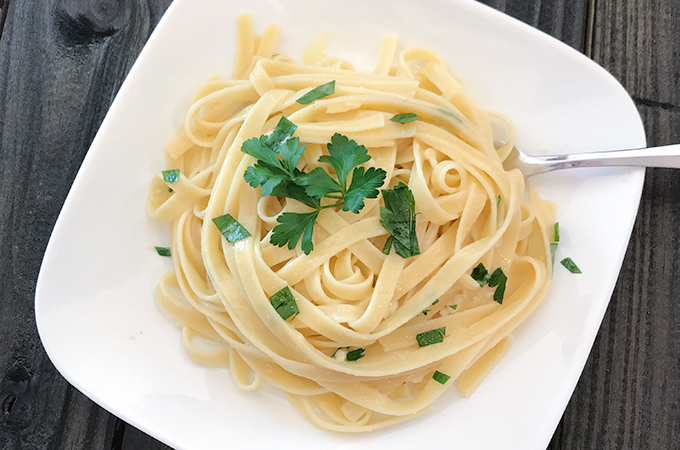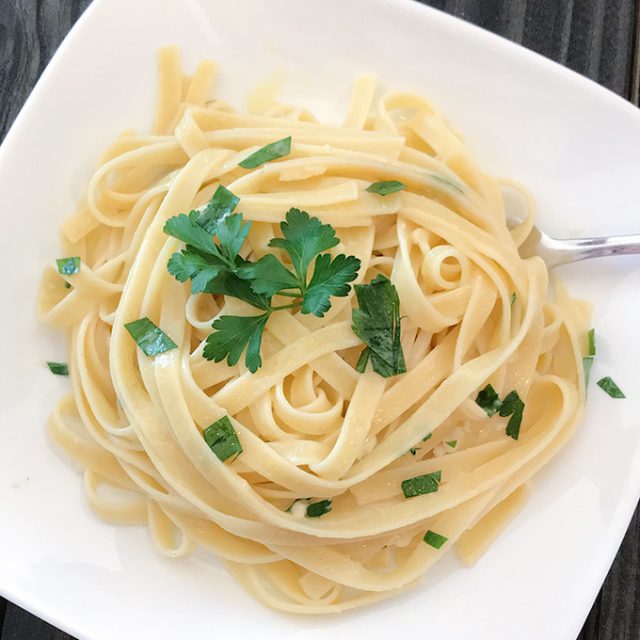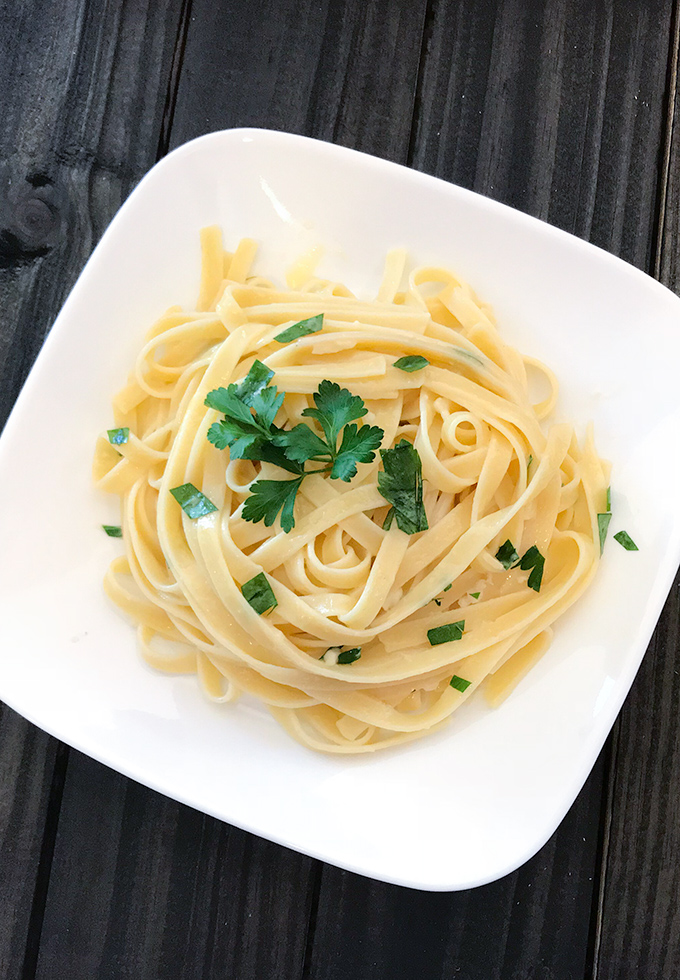Okay, this is my simple take on the simple Italian pasta dish fettuccine alfredo. The story goes that fettuccine alfredo was invented in the early 20th century by an Italian restaurateur by the name of Alfredo Di Lelio. Mr. Di Lelio’s alfredo sauce is a mixture of butter and parmesan cheese. Certainly this was not the first invention of pasta with butter and parmesan cheese, as this was described long before the 20th century. But, Mr. Di Lelio’s idea was to add lots of extra butter to the dish and let the butter incorporate the parmesan cheese. He found that these simple ingredients would form into a rich white creamy sauce. The legend goes that he made this recipe to help his pregnant wife to eat and keep up her strength, which was successful. He then sold the dish in his restaurant thereafter.
Eventually, of course, that recipe came to America. The American dish is somewhat different than the original Italian dish though. The American dish adds heavy cream to the mix to create the creamy sauce and help the butter incorporate the cheese. But this is a cheat to help keep the butter sauce from breaking and to aid in creating the creamy texture alfredo is known for. Nothing against adding some cream, it is still absolutely delicious, but that is not the traditional Italian way of making fettuccine alfredo. Using proper technique and ingredients, it is possible to make a delicious alfredo sauce that doesn’t require heavy cream.

So here’s a few tips for trying to create a delicious alfredo sauce without resorting to extra heavy cream.
First, use a creamy butter. This recipe calls for using Irish butter. Yeah, I know, weird right? Why Irish butter? Because Irish butter is creamier than the usual butter you can get in America, and it is readily available. It’s a little more money, but it will be worth it, trust me.
Second, grate the parmesan cheese into a fine powder. Grating into a fine powder helps the cheese to become incorporated into the butter while being heated up, and will prevent the cheese from becoming stringy. If you grate the cheese into larger flakes the cheese will most certainly becoming stringy and clumpy. I happen to think that it is still delicious if that happens, but for this sauce we are really trying for a creamy smooth sauce.
Third, use a top quality parmesan cheese. This makes a huge difference. I love adding Parmigiano-Reggiano cheese to this dish. It truly is the king of cheeses and will provide the perfect creamy nutty savory flavor to the dish that we are looking for. Generic parmesan cheese might just be a little too bland in this dish, so go for the best Italian cheese you can get instead.
Fourth, melt the butter gently and try to do so in a way that does not completely separate the butter into its component parts. The way I do this is to gently begin softening the butter in a skillet and adding in a few tablespoons of the hot pasta water. Then gently stir the butter into the hot water. This will prevent the butter from becoming separated and maintain a good emulsification of the butter, although melted. You will then add additional pasta water when the al dente fettuccine is added to the skillet. The fettuccine should be wet when added into the skillet, as the pasta water will also help to create the alfredo sauce. Just follow these tips and the recipe below and you can enjy this simple Italian pasta dish too.
Now get ready to make some classic fettuccine alfredo!

- 1/2 pound dry fettuccine
- 2 tablespoons Irish butter (cut into small cubes (Kerrygold works well))
- 2/3 cup finely grated Parmigiano-Reggiano cheese
- 1 clove fresh minced garlic
- 1 teaspoon fresh Italian flat parsley
- pinch of black pepper or pinch of crushed red pepper (optional, use red pepper to add some heat)
-
Begin boiling the fettuccine in salted water according to the box directions.
-
At the same time, begin warming a large skillet over low heat. Once the skillet is warmed, add the butter, which should just begin to gently melt. Once the pasta is boiling, take 2-3 tablespoons of the pasta water and add to the skillet to further warm the butter and start it melting. This method of melting the butter is designed to prevent it from separating completely. This is called beurre monte, and results in a thick buttery sauce without putting the butter under too much stress. Once the beurre monte is made, add the minced garlic clove.
-
When the fettuccine is cooked al dente, turn the skillet up to medium, remove the pasta from the water with tongs, and add directly to the skillet. You want the pasta to be wet here as the hot pasta water will help create the sauce.
-
Stir the fettuccine into the butter sauce so it is well coated. Add one half of the cheese and continue to stir, incorporating the cheese into the mixture. Then add the rest of the cheese and keep stirring.
-
The finely grated cheese should be able to be mixed into the butter mixture without clumping or becoming stringy. If the cheese does become too clumpy or stringy, or if you notice that the butter is separated, you can add some cream, perhaps a tablespoon at a time to try to assist the cheese in becoming incorporated and/or to fix the butter sauce. You can even add the cream as a matter of course, but this is widely considered to be cheating and not the classic way of making alfredo. Of course that doesn't mean it is not delicious.
-
Once the sauce is created add the fresh parsley and give it one last mix.
-
Dole out the pasta into separate plates and enjoy!

Leave a Reply